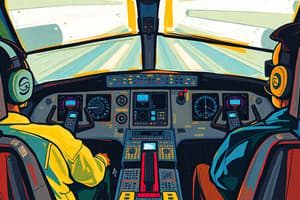Podcast
Questions and Answers
How does a strong therapeutic alliance influence patient adherence to treatment?
How does a strong therapeutic alliance influence patient adherence to treatment?
It improves adherence as patients feel more connected to their physiotherapist and understand the treatment purpose.
What role does the therapeutic alliance play in clinical outcomes for physiotherapy patients?
What role does the therapeutic alliance play in clinical outcomes for physiotherapy patients?
It predicts better clinical outcomes, resulting in greater pain reduction and improved functional recovery.
Why is patient satisfaction closely linked to the therapeutic alliance?
Why is patient satisfaction closely linked to the therapeutic alliance?
It is linked to the therapist's empathy, communication, and respect towards the patient.
How can the therapeutic alliance contribute to reducing drop-out rates in rehabilitation?
How can the therapeutic alliance contribute to reducing drop-out rates in rehabilitation?
In what ways does a strong therapeutic alliance empower patients in their recovery?
In what ways does a strong therapeutic alliance empower patients in their recovery?
Explain the significance of communication within the cockpit model of physiotherapy.
Explain the significance of communication within the cockpit model of physiotherapy.
What is the primary idea behind the cockpit model in physiotherapy?
What is the primary idea behind the cockpit model in physiotherapy?
How does the Cockpit Model emphasize the concept of therapeutic alliance in healthcare?
How does the Cockpit Model emphasize the concept of therapeutic alliance in healthcare?
How should physical therapists adjust their treatment plans according to patient needs?
How should physical therapists adjust their treatment plans according to patient needs?
In what ways does the Cockpit Model empower patients during their rehabilitation?
In what ways does the Cockpit Model empower patients during their rehabilitation?
What role does communication play in the success of the Cockpit Model?
What role does communication play in the success of the Cockpit Model?
How should physiotherapists adjust treatment plans according to the Cockpit Model?
How should physiotherapists adjust treatment plans according to the Cockpit Model?
Describe the concept of shared responsibility in the Cockpit Model.
Describe the concept of shared responsibility in the Cockpit Model.
What is the significance of patient feedback in the Cockpit Model?
What is the significance of patient feedback in the Cockpit Model?
How does the Cockpit Model facilitate collaborative care?
How does the Cockpit Model facilitate collaborative care?
Explain how the roles of pilot and co-pilot in the Cockpit Model enhance treatment effectiveness.
Explain how the roles of pilot and co-pilot in the Cockpit Model enhance treatment effectiveness.
What is the therapist’s primary obligation in the therapy process?
What is the therapist’s primary obligation in the therapy process?
How does the hands-off approach in the cockpit model enhance patient empowerment?
How does the hands-off approach in the cockpit model enhance patient empowerment?
What are some barriers to effective communication in therapy as outlined in the cockpit model?
What are some barriers to effective communication in therapy as outlined in the cockpit model?
Describe how patient readiness impacts the implementation of therapy plans.
Describe how patient readiness impacts the implementation of therapy plans.
What role does patient feedback play in adjusting treatment plans?
What role does patient feedback play in adjusting treatment plans?
In what ways can a therapist effectively monitor a patient's progress in therapy?
In what ways can a therapist effectively monitor a patient's progress in therapy?
What are SMART goals, and why are they important in the therapy process?
What are SMART goals, and why are they important in the therapy process?
Explain the concept of the cockpit model in the context of manual therapy.
Explain the concept of the cockpit model in the context of manual therapy.
Flashcards
Therapeutic Alliance
Therapeutic Alliance
A strong connection between a patient and physiotherapist, vital for successful therapy.
Improved Adherence
Improved Adherence
Patients are more likely to follow their treatment plan with a strong alliance, boosting success.
Better Patient Outcomes
Better Patient Outcomes
Therapeutic alliance leads to better results, quicker recovery and less pain.
Patient Satisfaction
Patient Satisfaction
Signup and view all the flashcards
Drop-Out Rates
Drop-Out Rates
Signup and view all the flashcards
Empowerment
Empowerment
Signup and view all the flashcards
Cockpit Model
Cockpit Model
Signup and view all the flashcards
Communication
Communication
Signup and view all the flashcards
Physiotherapist's role (Pilot)
Physiotherapist's role (Pilot)
Signup and view all the flashcards
Patient's role (Co-pilot)
Patient's role (Co-pilot)
Signup and view all the flashcards
Communication (Cockpit Model)
Communication (Cockpit Model)
Signup and view all the flashcards
Shared Responsibilities
Shared Responsibilities
Signup and view all the flashcards
Patient's responsibility
Patient's responsibility
Signup and view all the flashcards
Physiotherapist responsibilities
Physiotherapist responsibilities
Signup and view all the flashcards
Feedback Loop
Feedback Loop
Signup and view all the flashcards
Therapist's Obligation
Therapist's Obligation
Signup and view all the flashcards
Cockpit Model - Challenges
Cockpit Model - Challenges
Signup and view all the flashcards
Cockpit Model - Co-Creation
Cockpit Model - Co-Creation
Signup and view all the flashcards
Exercise Prescription
Exercise Prescription
Signup and view all the flashcards
Progress Monitoring
Progress Monitoring
Signup and view all the flashcards
Cockpit Model - Hands-on
Cockpit Model - Hands-on
Signup and view all the flashcards
Cockpit Model - Reasoning
Cockpit Model - Reasoning
Signup and view all the flashcards
Patient Adherence
Patient Adherence
Signup and view all the flashcards
Study Notes
MPTY03 - Cockpit Model
- A multimodal tool for patient-centered care
- Aims to be a collaborative model between patient and therapist
- Encourages communication and shared responsibility
- The model emphasizes the importance of communication, shared responsibility, and active participation
- Both patient and therapist share decision-making responsibilities
Bio-Psycho-Social Model
- Holistic approach considering biological, psychological, and social factors in understanding patient health
- Biological factors: Anatomy, physiology, and pathology of the patient
- Psychological factors: Stress, anxiety, depression, and pain perception are crucial to overall health
- Social factors: Patient's environment, support systems, work/family responsibilities, socioeconomic status, cultural background, and access to healthcare greatly impact the patient's ability to participate in therapy
Cockpit Model - What is it?
- Physiotherapist and patient interact as co-pilots navigating a shared journey to rehabilitation and recovery
- Emphasizes communication, shared responsibility, and active participation
Cockpit Model - Pilot (Physiotherapist)
- The physiotherapist acts as the expert pilot
- Guides the treatment process and uses clinical reasoning, evidence-based practice, and their expertise
- Responsibilities include:
- Educating the patient
- Clear communication
- Monitoring patient progress
- Adjusting the treatment plan, as needed
- Ensuring the patient understands their role in recovery
Cockpit Model - Co-Pilot (Patient)
- The patient acts as the co-pilot, providing real-time feedback
- Feedback helps adjust the treatment plan
- Provides information on symptoms, challenges, and progress in relation to their recovery
- Continuous feedback loop essential for optimizing care and allows for adjustments as needed
Cockpit Model - Communication
- Trust and clear communication is crucial to the model's success
- Both physiotherapist and patient communicate openly and transparently
- Patient needs to feel comfortable voicing concerns and their input valued
- Communication is two-way or bidirectional
Cockpit Model - Shared Responsibilities
- Responsibility for rehabilitation process is shared between physiotherapist and patient
- Physiotherapist responsible for providing a safe and effective treatment plan
- Patient responsible for implementing the plan, providing feedback, and adhering to lifestyle recommendations
- Therapist has an obligation to provide mean, but not to succeed as success relies on patient's action plan
- Patient needs to follow through with actions as planned.
Cockpit Model - Challenges
- Non-Adherence: Patients may not follow the treatment plan
- Communication Barriers: Misunderstandings between patient and physiotherapist
- Patient Readiness: Patients may not be ready or willing to take on an active role
Cockpit Model - Application - Hands-on approach
- Co-Create Goals: Therapist and patient define SMART goals using the SMART method.
- Prescribe Exercises: Exercise program is collaboratively developed, with the patient understanding the purpose.
- Monitor Progress: Regular check-ins monitor progress using objective and subjective measures.
- Concept derived from control panel of cockpit
- Reasoning model for the application and adaptation of parameters in manual therapy techniques
High SIN
- Keeping the indicators on the left to use a faster rhythm and nonspecific location for treatment.
Low SIN
- Keeping the indicators on the right to use a slow pace and specific location in treatment.
Studying That Suits You
Use AI to generate personalized quizzes and flashcards to suit your learning preferences.
Related Documents
Description
Explore the Cockpit Model, a collaborative approach in patient-centered care involving both therapists and patients. Understand the significance of the Bio-Psycho-Social Model, which integrates biological, psychological, and social factors impacting health and therapy participation.




